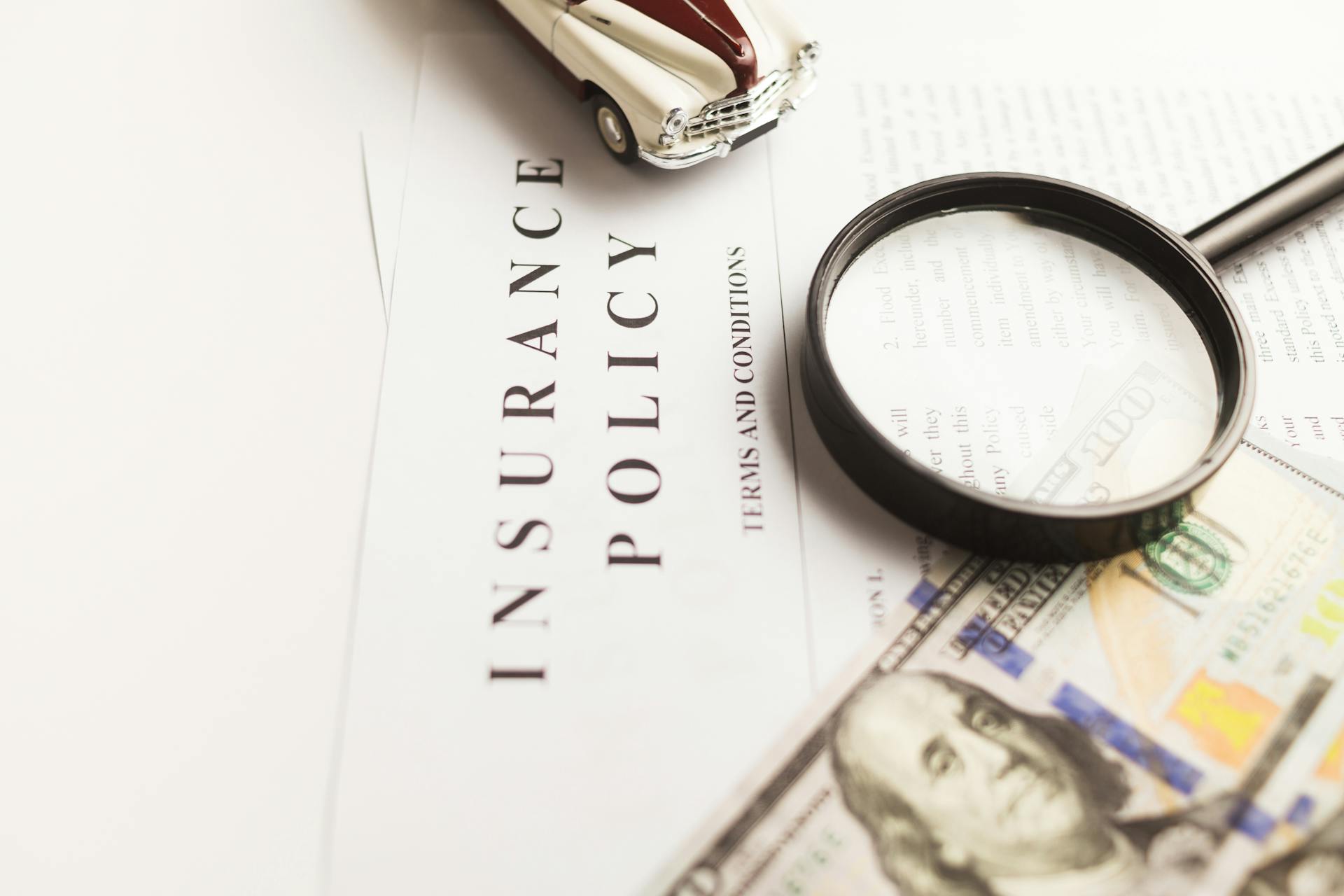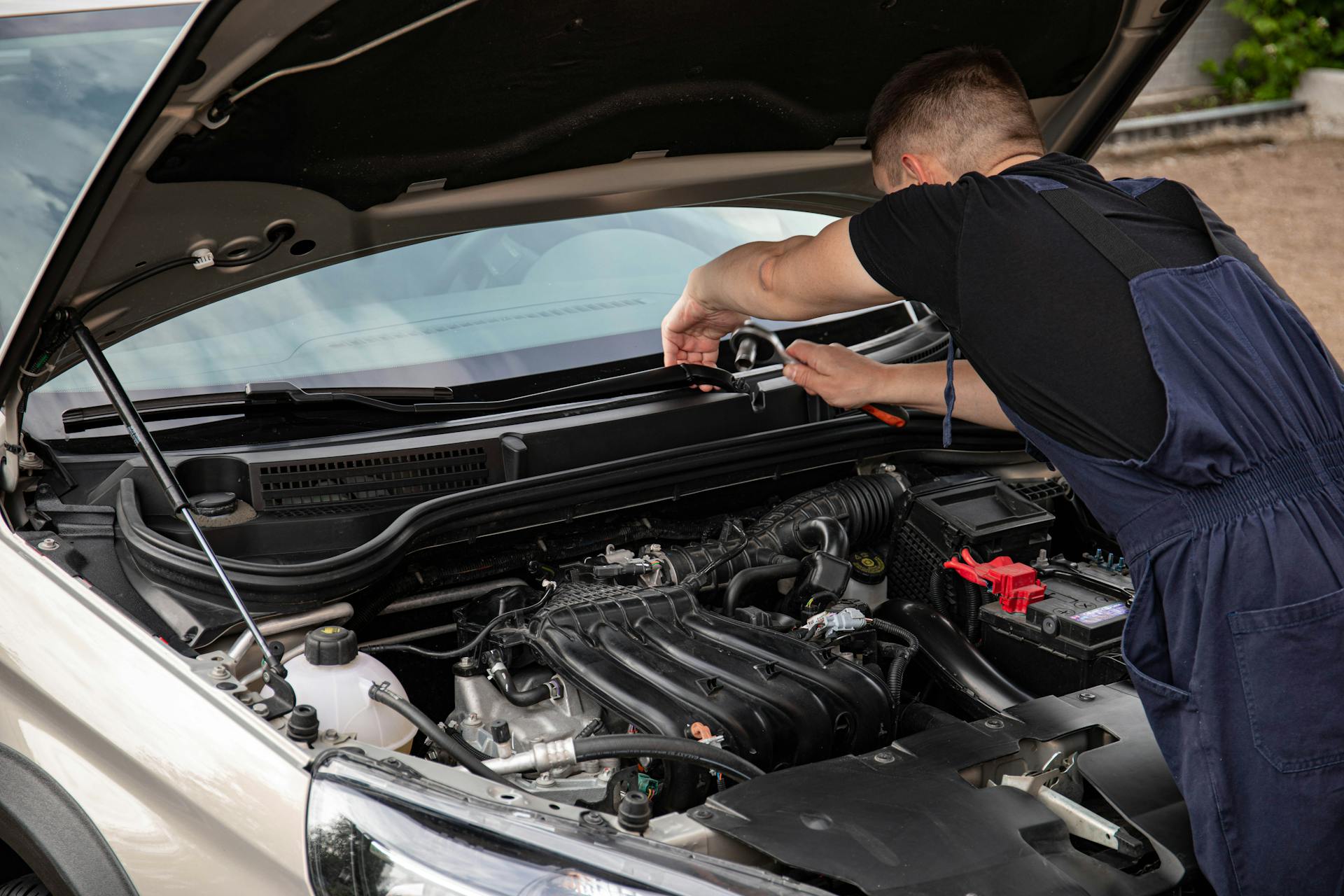
Leasing a car can be a great way to drive a new vehicle without the long-term commitment of buying. However, at the end of the lease, car companies often inspect the vehicle to check for any damage or excessive wear and tear.
Excessive mileage is one of the main concerns for car companies. If you've exceeded the agreed-upon mileage limit, you'll likely be charged for the excess miles driven.
Car companies also check for any cosmetic damage, such as scratches, dents, or worn-out tires. They'll inspect the interior as well, looking for any stains, tears, or missing trim pieces.
You'll be responsible for any missing or damaged items, including the spare tire, jack, and other accessories that came with the car.
For another approach, see: No Credit Check Car Lease
Return Inspection Process
The return inspection process can be a stressful time for car lessees. An inspection usually takes about an hour.
Lease finance companies use various methods to inspect their vehicles, with some hiring outside independent inspection companies and others relying on the dealer to do the inspection at the time of return.
Additional reading: What Car Companies Check after Lease Ends
Many lease finance companies, such as Honda Finance and Ford Credit, use a standard checklist and form to make detailed notes of their findings, including photographs of problem areas.
Inspectors look for unrepaired damages, poorly repaired damages, large dents and scratches, and other issues, including worn, patched, or mismatched tires, non-working equipment and lights, and signs of mechanical or engine problems.
You'll receive a copy of the inspection report, but it's essential to review it carefully and notify the lease company if you disagree with any findings.
The lease company will bill you for excessive wear or mileage, as well as a "disposition fee" that's typically around $350, unless you made a security deposit at the beginning of your lease, which may be refunded minus any charges.
You might like: Car Lease Limited Company
Lease Inspectors' Responsibilities
Lease inspectors are responsible for thoroughly checking out a lease vehicle for signs of excessive wear, damages, and unrepaired damages. They use a standard checklist and form to make detailed notes of their findings.
Inspectors will take photographs of problem areas to document any issues. They will also send a copy of the report to you and the lease finance company at the same time.
The inspector's report will be detailed, but it doesn't mean the lease company will send you a bill for every little thing noted as a problem. You should review the report carefully and notify the lease company if you disagree with anything.
Inspectors don't just look for problems, they also document the vehicle's condition, which can help you avoid unnecessary costs when returning the lease car.
On a similar theme: Tesla Company Car Lease
Inspection Items
Inspectors look for unrepaired damages, poorly repaired damages, large dents and scratches, broken or cracked glass, badly scratched wheels, non-working equipment and lights, equipment that may have been removed or modified, worn, patched, or mismatched tires, signs of mechanical or engine problems, burned seats, and interior damage.
Inspectors are particularly strict about tires, requiring a minimum of 3/32" or 1/8" of tread depth at the lowest wear area. They also check to ensure all tires are the same size and rating as the original tires, and that all tires are part of a matching set.
If you're unsure about whether a particular issue should be fixed, it's best to ignore it and take your chances, as repairing minor damages may be unnecessary and a waste of money.
What Do Inspectors Examine?
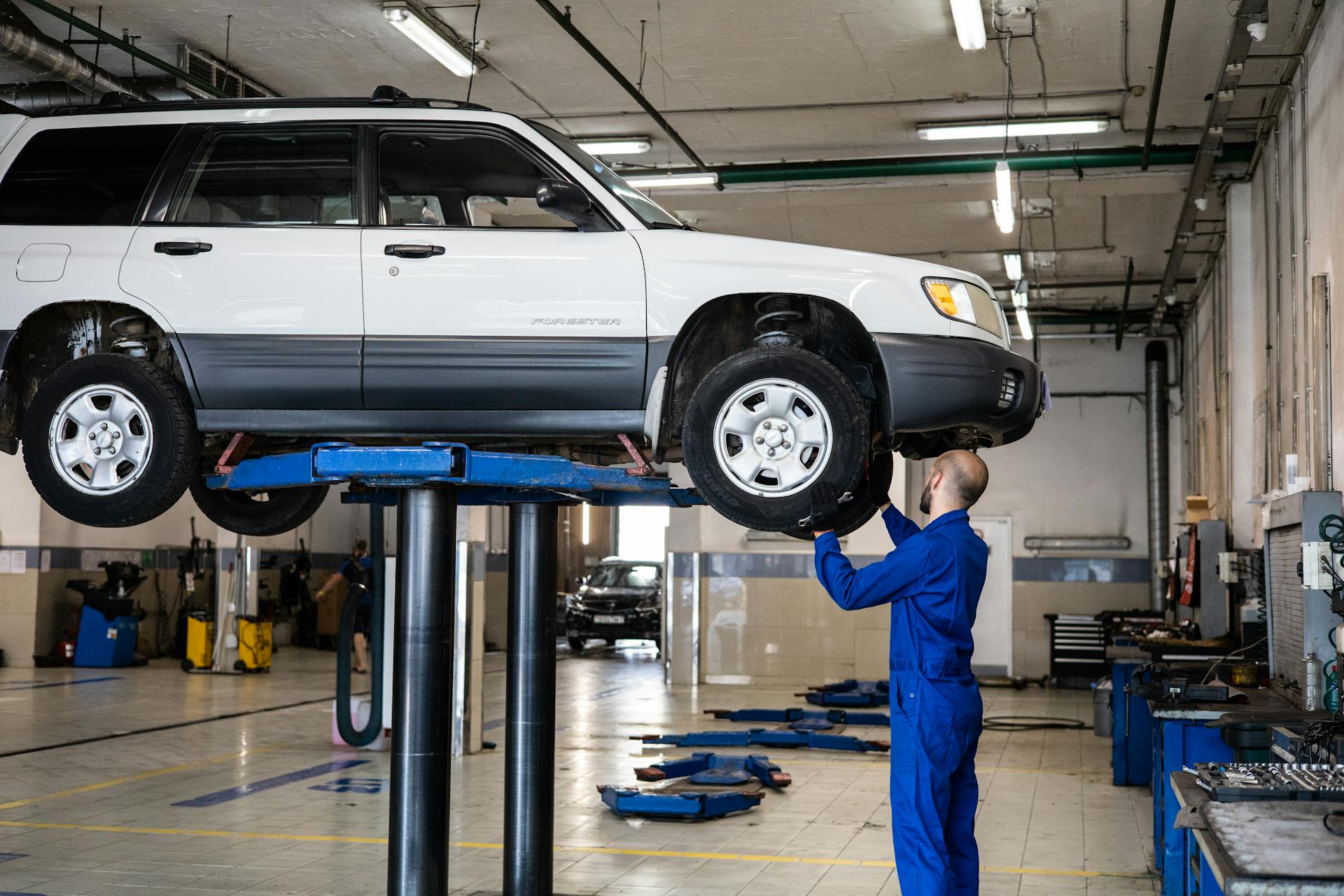
Inspectors examine a wide range of items to determine if your leased vehicle meets the lease company's standards. They look for unrepaired damages, poorly repaired damages, and large dents and scratches.
Inspectors also check for broken or cracked glass, badly scratched wheels, and non-working equipment and lights. This includes checking if equipment has been removed or modified.
Inspectors will look at the tires, making sure they have at least 3/32″ or 1/8″ of tread depth at the lowest wear area. They will also check if all tires are the same size and rating as the original tires and that they are a matching set.
Inspectors examine the interior of the vehicle, looking for signs of mechanical or engine problems, burned seats, and interior damage.
Here are some specific items inspectors look for:
- Scratches over 25mm (relative to the vehicle’s age and mileage)
- Scratches under 25mm (where the primer and bare metal is showing)
- Accident damage and dents
- Missing sets of keys
- Missed services
- Missing documentation
- Damaged or stained interior
- Windscreen chips and scratching (Light scratching is acceptable provided it does not interfere with the driver’s line of sight)
- Wheel damage due to kerbing
Vehicle Equipment
When you're about to return your leased vehicle, it's easy to overlook some of the equipment you took out at the start. Returning your vehicle with equipment missing is almost certainly going to result in a charge.
Most lease agreements run for 2-5 years, so it's worth checking if you've got everything back in its place. The parcel shelf is one of the items you should check.
You should also make sure the locking wheel nut is still in place. If you're leasing an electric or PHEV vehicle, don't forget to return the charging cables. The service book is another item that's easy to overlook.
A spare key, spare wheel, or tyre inflation kit are other things you should double-check before returning your vehicle.
Consider reading: Lease to Own Car No Credit Check
Potential Issues
Inspectors look for unrepaired damages, poorly repaired damages, large dents and scratches, broken or cracked glass, badly scratched wheels, non-working equipment and lights, equipment that may have been removed or modified, worn, patched, or mismatched tires, signs of mechanical or engine problems, burned seats, and interior damage.
Inspectors may also notice signs of wear and tear on the vehicle's interior, including worn-out seats or carpets. This can be a major issue if not properly addressed.
Inspectors will thoroughly check the vehicle's exterior for any damage, including large dents and scratches, which can be costly to repair.
Damage
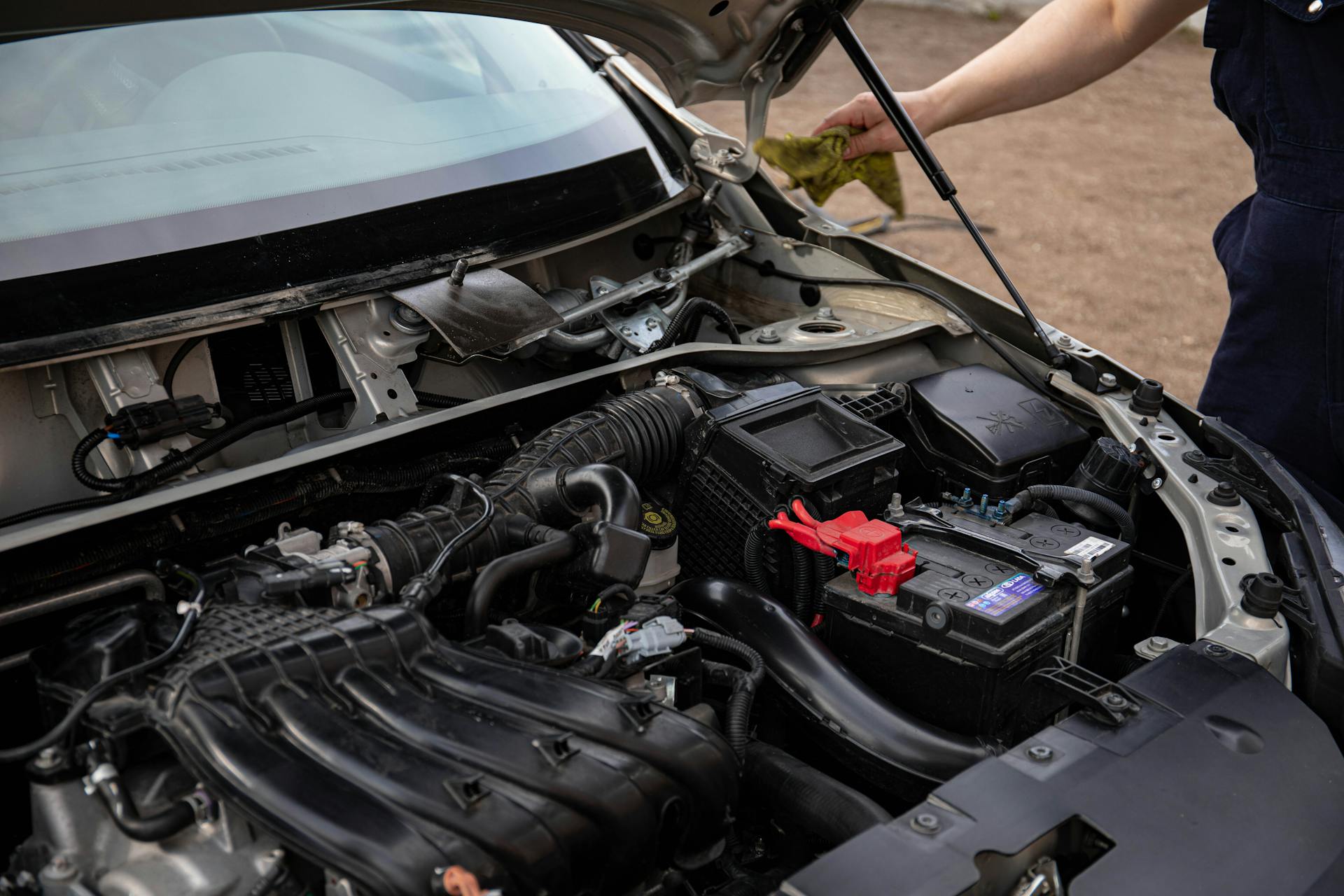
Damage can be a costly issue when returning a leased car. Most car lease contracts require that you return a car with no less than 3/32″ or 1/8″ of tread depth at the lowest wear area of any tire on the car.
Inspectors look for unrepaired damages, poorly repaired damages, large dents and scratches, broken or cracked glass, badly scratched wheels, non-working equipment and lights, equipment that may have been removed or modified, worn, patched, or mismatched tires, signs of mechanical or engine problems, burned seats, and interior damage.
Returning a lease car with significant damage can lead to significant cost, and once the vehicle has been collected, your option to pay privately for repairs has gone. Be sure to inspect the vehicle for damage and consider if it's worth having it repaired before the return.
Inspectors also check for tires that are of the same size and rating as the original tires, and that all tires are part of a matching set. Some lease companies even require that the spare in the trunk be part of the matching set.
You might like: Returning Lease Car
Excess Mileage
Excess mileage can catch you off guard if you're not aware of the terms in your contract. An excess mileage charge may occur at the end of a contract if the vehicle is returned with more than the contracted mileage.
Your signed contract will set out the Pence Per Mile for every mile you exceed your annual mileage allowance.
If you're unsure about your contract or need help understanding the terms, don't worry - there are resources available to you. Gofor Finance offers free end of contract reviews through their partnership with the RAC.
Take a look at this: Understanding a Car Lease
Preparation and Timing
Your return date is the annual birthday of when you took the lease, depending on how many years you took it for. Some lenders will allow a 24-hour grace period if the return date falls on a Sunday, but it's always best to check.
You'll need to return your vehicle before the expiry date to avoid being billed pro-rata for the number of days you've used it. This means you'll be charged for the extra time you keep the vehicle beyond the lease end.
Service History
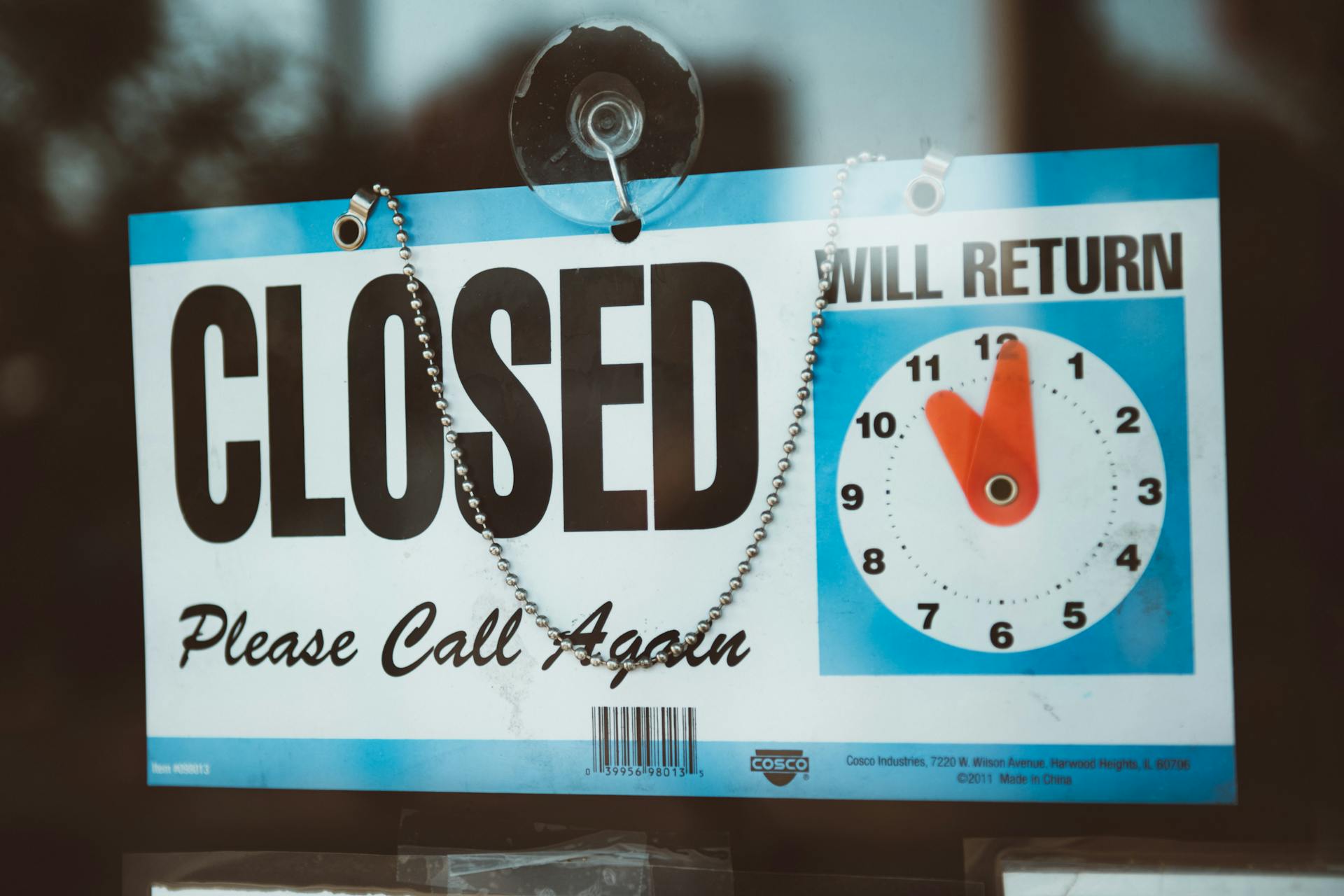
Keeping your vehicle's service history up to date is crucial. You must service your vehicle in line with the manufacturer's recommendation.
Most finance providers will be satisfied with the service taking place at a VAT registered garage, as long as they use genuine manufacturer parts. Some finance providers, however, insist it's done at the manufacturer-authorised dealer.
Failing to have the vehicle serviced will lead to an end of contract charge for the missed service. If you have a service or MOT due before the vehicle is returned, don't skip it.
Preparing Your Vehicle
Preparing your vehicle for return is a crucial step in the leasing process, and it's essential to do it right to avoid any unnecessary charges. Start by inspecting the vehicle 3 months before it's due to be returned to give yourself enough time to arrange for any necessary repairs.
The British Vehicle Rental and Leasing Association (BVRLA) provides a standard guide to wear and tear, but each finance company has its own guidelines, so be sure to check with your individual provider. You can also refer to the list below for some common issues that may incur charges.
- Scratches over 25mm (relative to the vehicle’s age and mileage)
- Scratches under 25mm (where the primer and bare metal is showing)
- Accident damage and dents
- Missing sets of keys
- Missed services
- Missing documentation
- Damaged or stained interior
- Windscreen chips and scratching (Light scratching is acceptable provided it does not interfere with the driver’s line of sight)
- Wheel damage due to kerbing
Make sure to check the vehicle's service history and ensure it's been serviced in line with the manufacturer's recommendations. Some finance providers require the service to be done at a manufacturer-authorised dealer, but most will accept a VAT-registered garage using genuine manufacturer parts.
Return Date
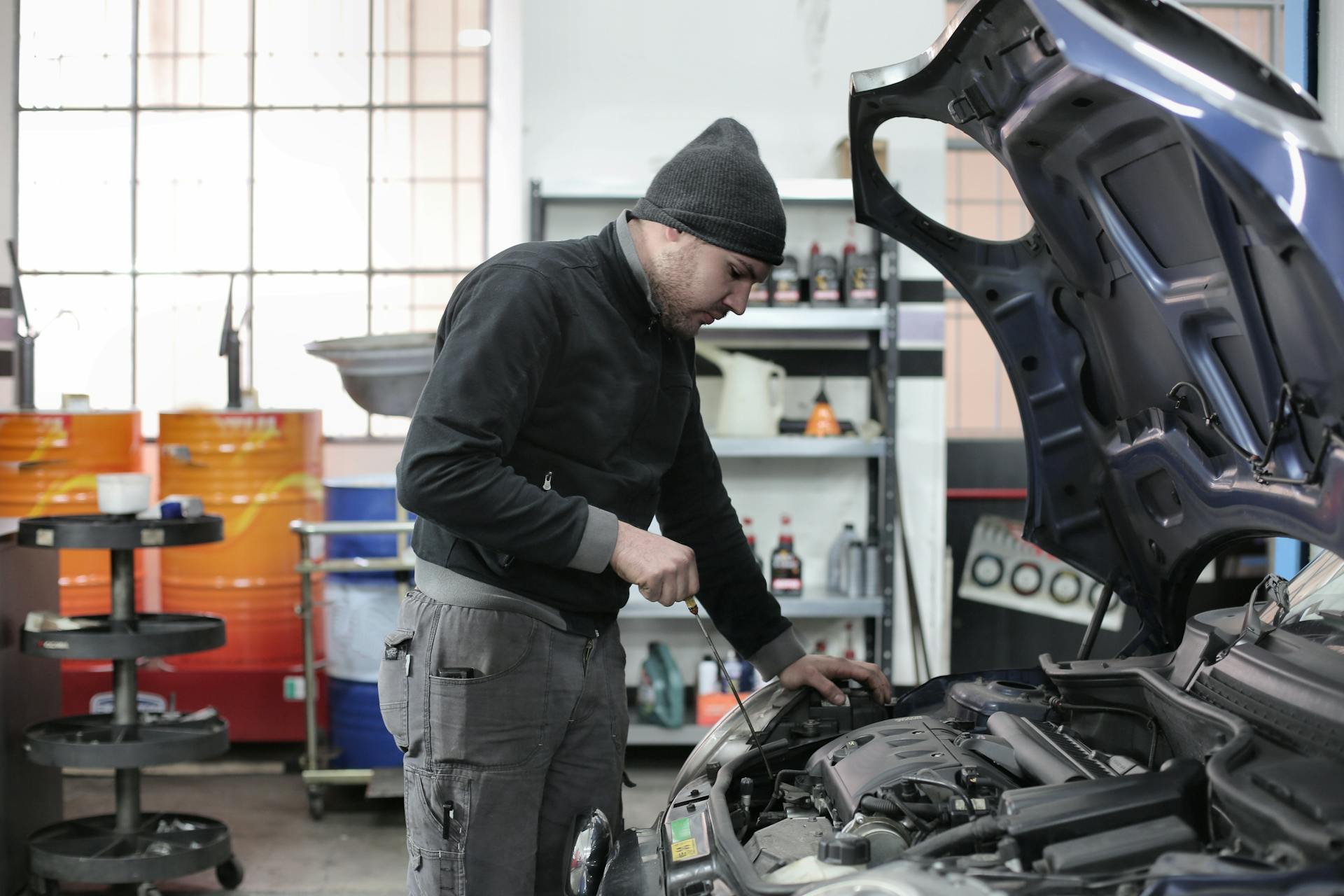
Your return date is the annual birthday of when you took the lease, depending on how many years you took it for.
Some lenders will allow a 24-hour grace period if the return date falls on a Sunday, so it's always a good idea to check.
Normally, if you return your vehicle after the expiry date, you will be billed pro-rata for the number of days you have used.
This means you'll be charged for the extra time, but it's not always a bad thing if you need to hang onto the vehicle for a little longer.
Sources
- https://www.leaseguide.com/articles/lease-return-inspection/
- https://www.linkedin.com/pulse/10-things-check-when-returning-lease-car
- https://www.gmfinancial.com/en-us/financial-resources/articles/lease-end-inspection.html
- https://www.gofor.co.uk/news/preparing-your-vehicle-for-the-end-of-the-lease
- https://www.carsmetics.com/returning-your-vehicle-at-the-end-of-a-lease/
Featured Images: pexels.com

